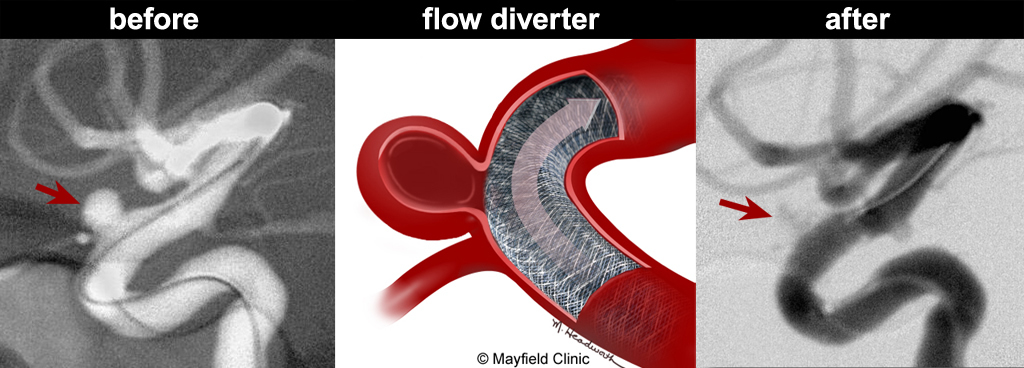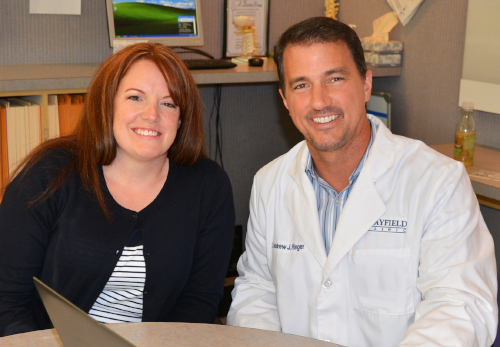
Lysa's story
ruptured aneurysm : Pipeline flow diverter
It was going to be an especially joyful Christmas. Lysa and her husband had just welcomed their fourth child a few weeks earlier, and their older children were mature enough to be fully attuned to the day's promise, swirling bout with the kind of high anticipation that leaves a permanent impression in parents' memories and hearts. But while Lysa was busy wrapping presents, she was suddenly struck with the worst headache of her life.
"It was so bad that I temporarily stopped what I was doing," she recalls. "It was the most awful headache you can possibly imagine. As the day progressed I did not feel any better. We were supposed to go to my in-laws' home, but my husband finally thought I should stay home. I went to bed at about 6 o'clock."
Lysa assumed that her problems were related to the recent birth of her baby. But when she awoke the next day, she couldn't see clearly. "It was almost double vision. I would see one and a half of everything," she says. She put cold compresses on her neck, which had stiffened, and took the maximum allowable dose of over-the-counter painkillers. Nothing helped.
Stoic, Lysa muddled through the next few weeks, then in January went to see her primary care physician. Lysa explained that she had fallen ill on Christmas and was still suffering from an extreme headache on the left side as well as vision problems. The physician, theorizing that Lysa had given herself a cluster headache because she had been taking over-the-counter medications, prescribed steroids and a steroid pack and recommended that she see an ophthalmologist.
Lysa scheduled an appointment with Ginger L. Henson, MD, of the Cincinnati Eye Institute.
After taking Lysa's family history and performing an exam, Dr. Rattan was unsure of what was causing Lysa's symptoms. So she ordered a CT scan, a test that supplied the answer: a bleeding aneurysm in the right hemisphere of Lysa's brain.
She was experiencing pain in the left side of her head because blood from the aneurysm was flowing in that direction. Lysa was referred to Andrew Ringer, MD, an endovascular specialist at the Mayfield Clinic, and Dr. Ringer promptly scheduled her for treatment at Good Samaritan Hospital.
On April 10 Dr. Ringer performed a three-hour endovascular procedure to shut down Lysa's aneurysm. He threaded a catheter up from the groin, through Lysa's body and up to her brain. Because of the shape and location of the aneurysm, Dr. Ringer chose to treat it with a new stent-like device known as the Pipeline® embolization device, a flow-diverter that redirects blood flow away from the aneurysm.
"With this device, we treat the artery that feeds the aneurysm, rather than treating the aneurysm itself," Dr. Ringer explains. "The Pipeline redirects the blood flow away from the aneurysm so it doesn't have a chance to bleed."

The device resembles a stent, but its consistency is more like cheesecloth, Dr. Ringer adds. "It is a finely woven material, and blood cannot easily get through the spaces. The tightly woven tube creates resistance to the blood flow, causing the blood to continue down the artery along the path of least resistance and in turn causing the aneurysm to eventually clot off, wither, and die."
The procedure went flawlessly, and Lysa was discharged from Good Samaritan the next day.
She notes that the procedure did cause a flare-up of her headache, which had dulled by the time she saw Dr. Ringer. But the pain lessened a little each day and gradually went away. "Other than a headache, the whole experience was easy and painless," Lysa says. Her vision, meanwhile, began improving within a few days and was normal within a week.
In retrospect, Lysa's headache was "a classic of case of a thunderclap headache, a textbook presentation of someone who has bled from an aneurysm," Dr. Ringer says. "That's a game-changer. It didn't creep up on her; it was persistent; it did not respond to medical therapy; it was the worst headache she had ever had. All of these signs point to a situation that requires a trip to the emergency department."
Fortunately for Lysa, her aneurysm did not rupture completely, and today, she is back in the routine of a busy, busy mom with four children to nurture. The headache and neurosurgical treatment, she says, "almost feels like a distant memory."
Hope Story Disclaimer -"Lysa's Story" is about one patient's health-care experience. Please bear in mind that because every patient is unique, individual patients may respond to treatment in different ways. Results are influenced by many factors and may vary from patient to patient.
"It was the most awful headache you can possibly imagine. As the day progressed I did not feel any better."

Lysa with Dr. Andrew Ringer

On April 10 Dr. Ringer performed a three-hour endovascular procedure to shut down Lysa's aneurysm. He threaded a catheter up from the groin, through Lysa's body and up to her brain.
Related links:
